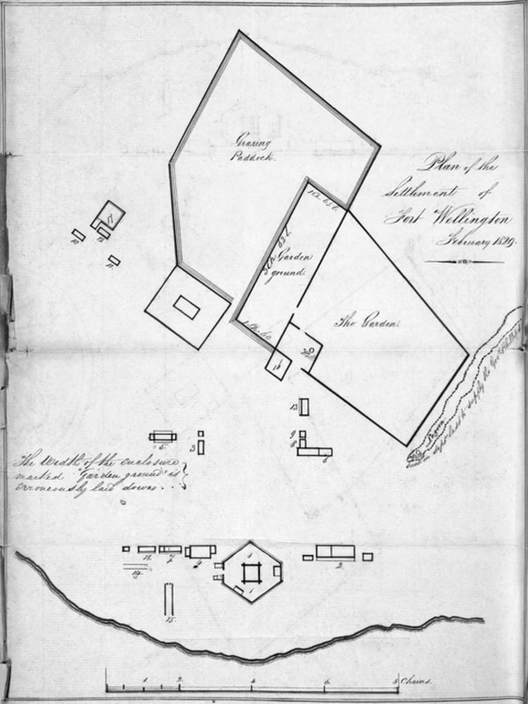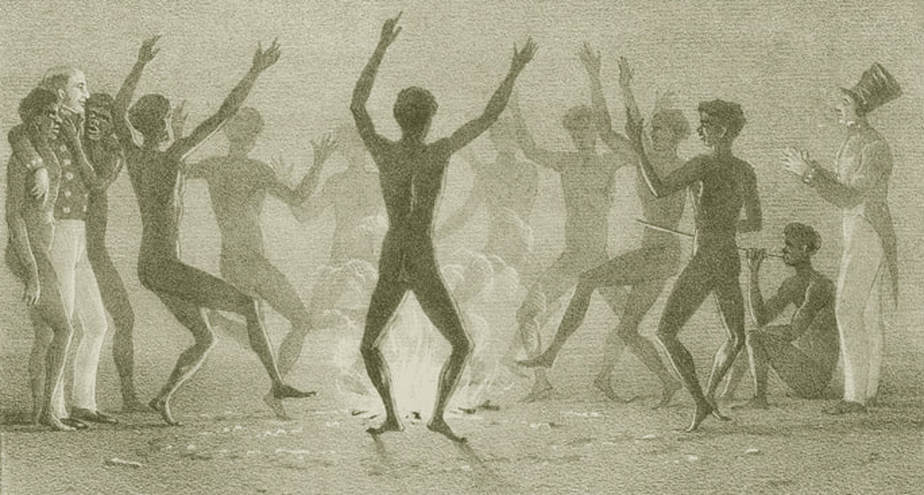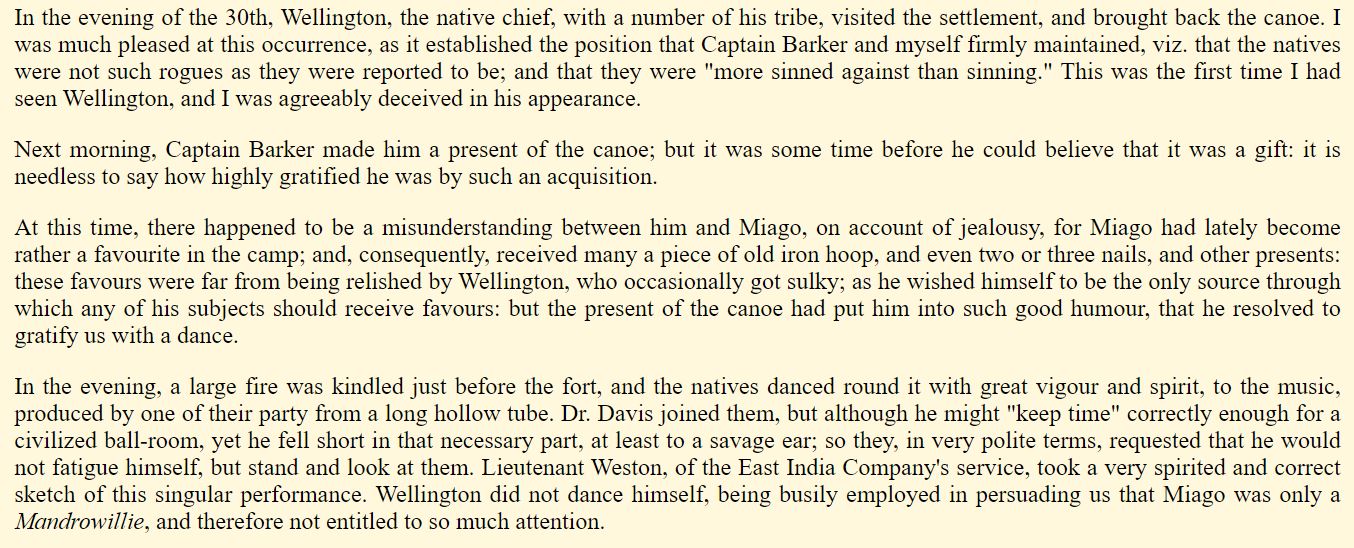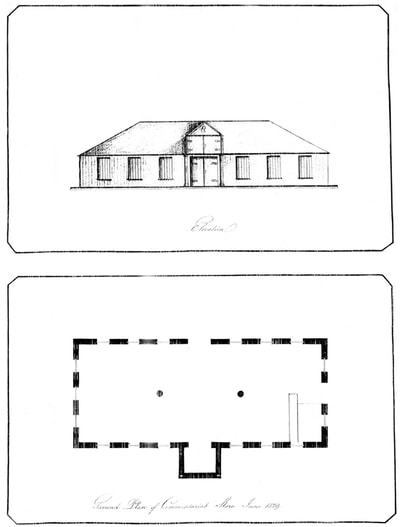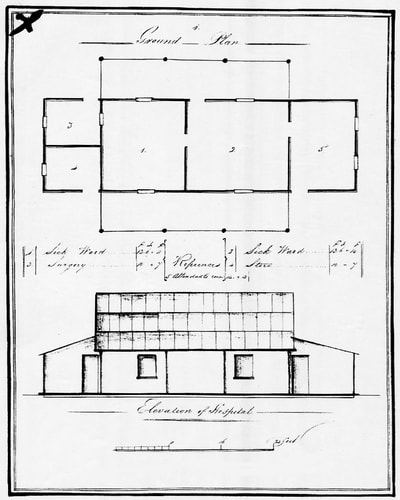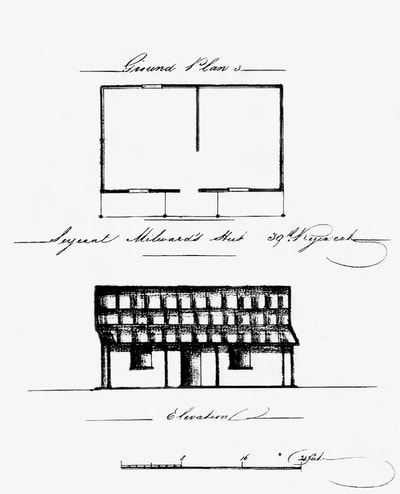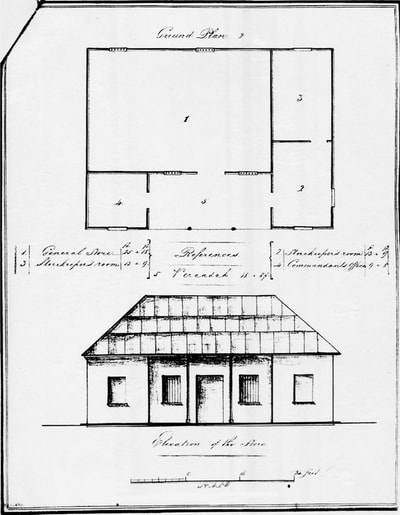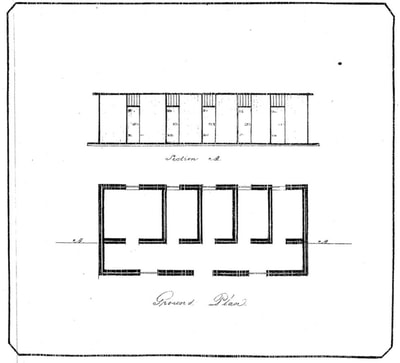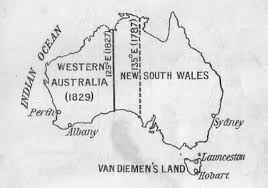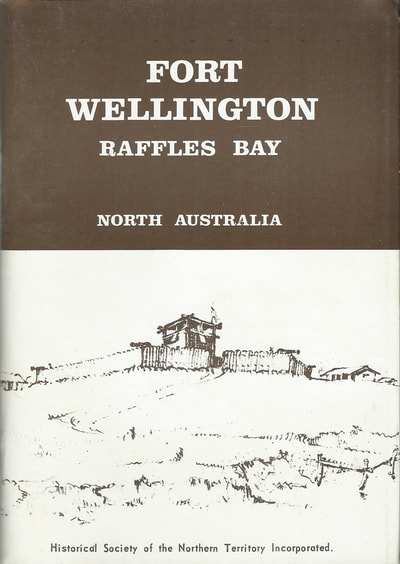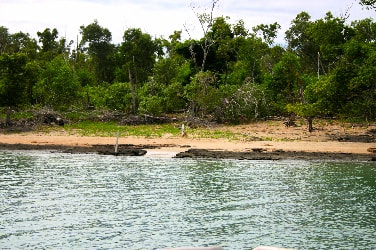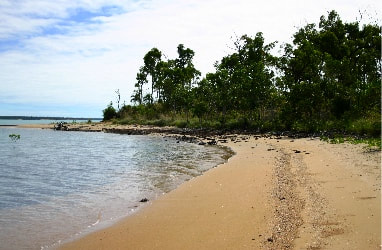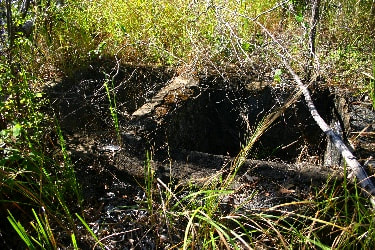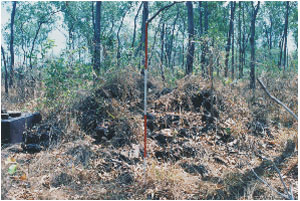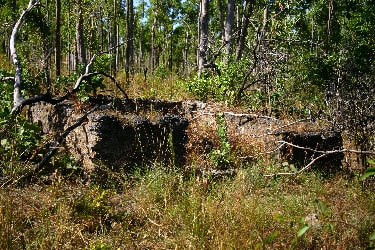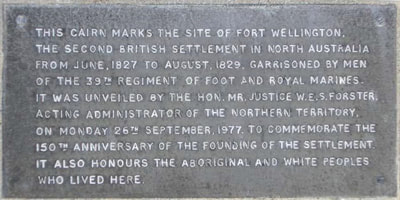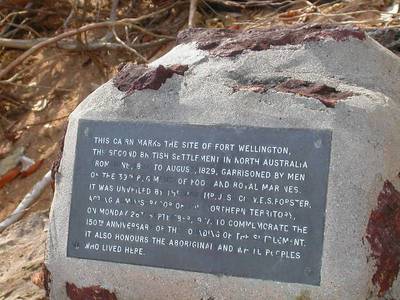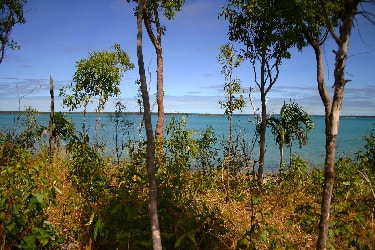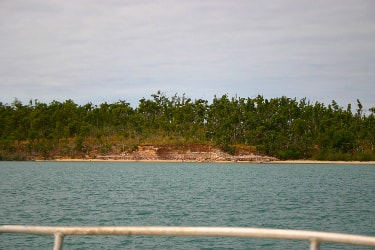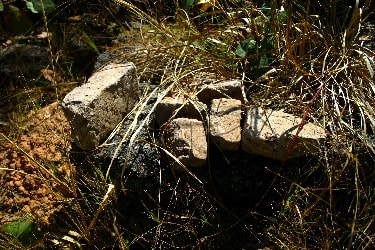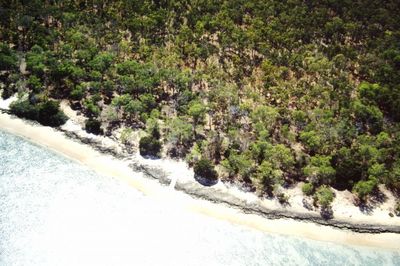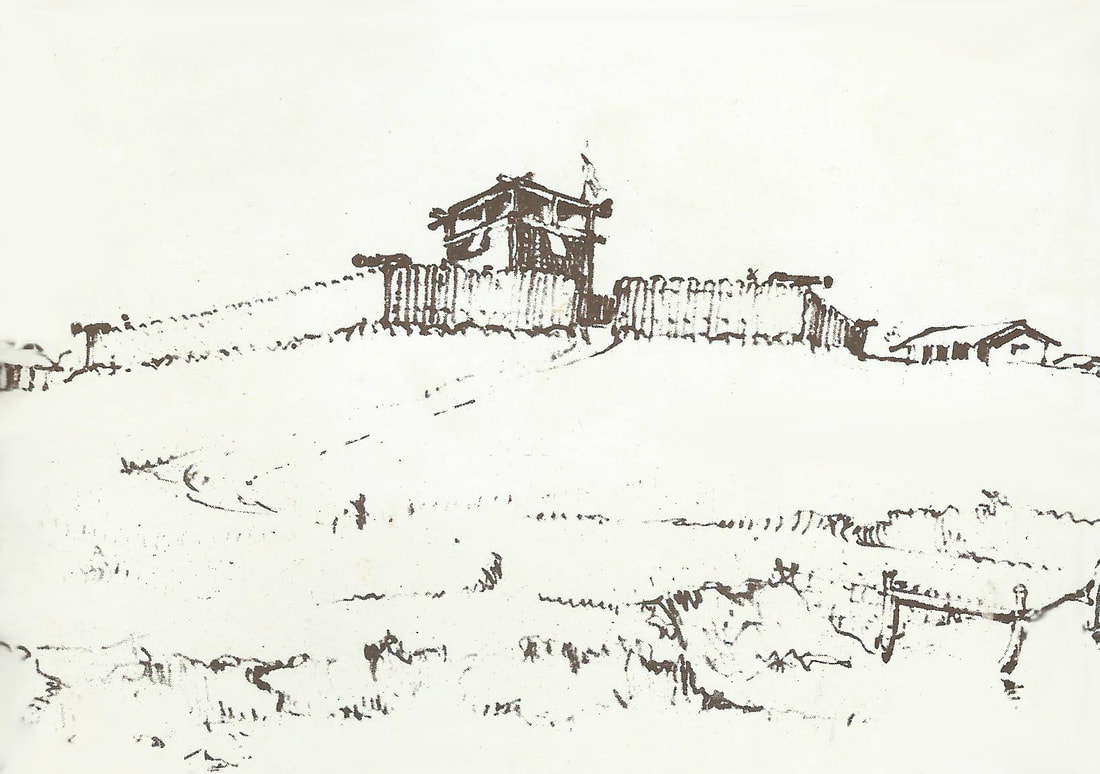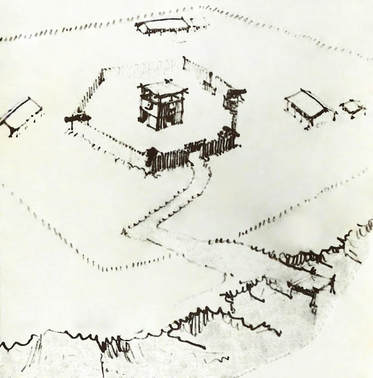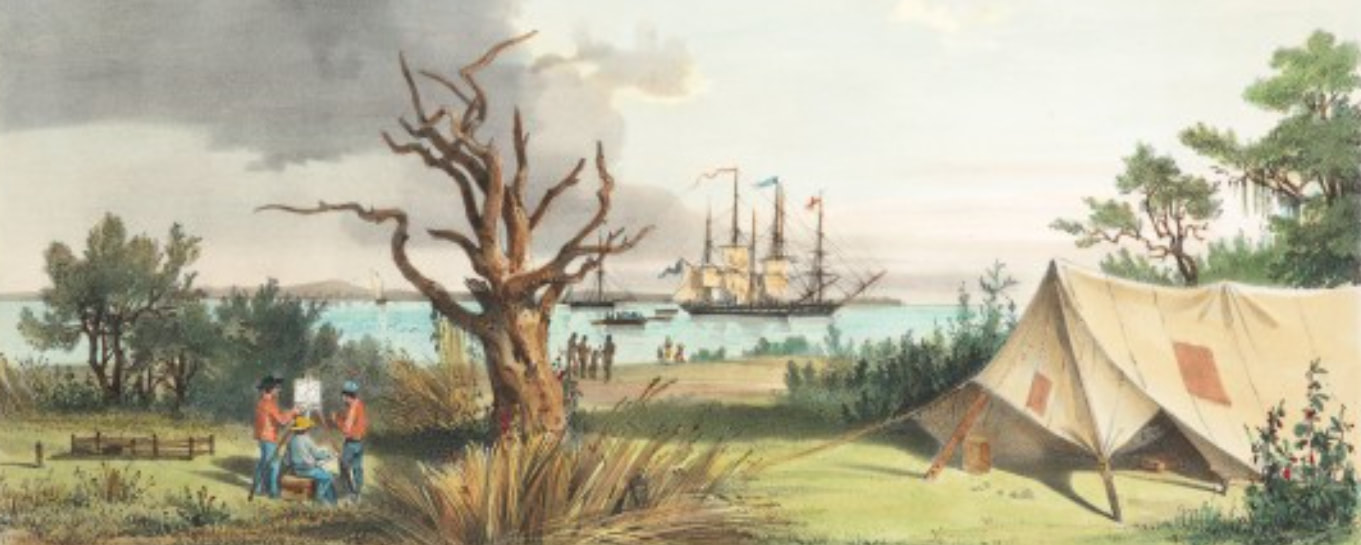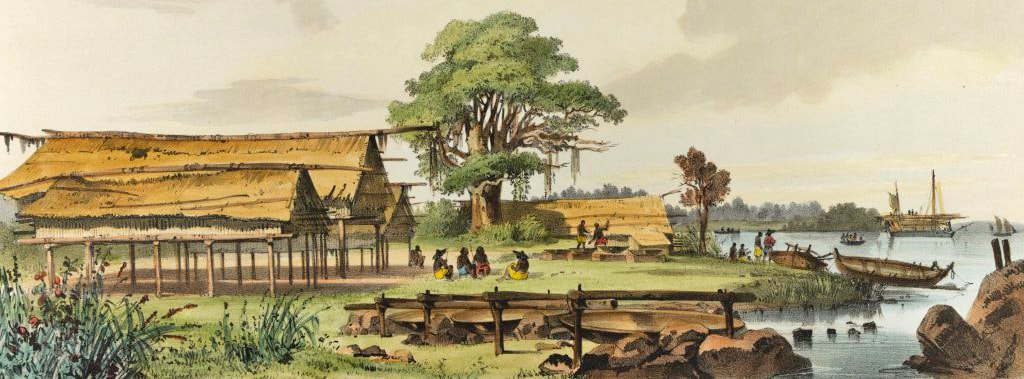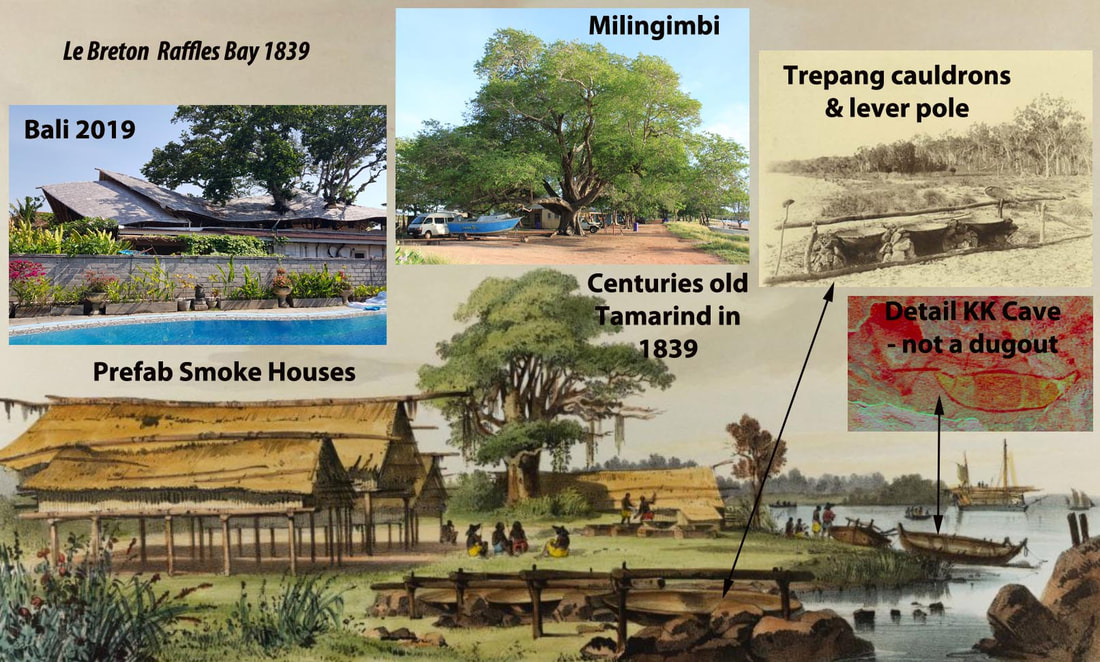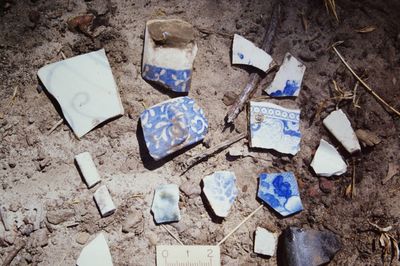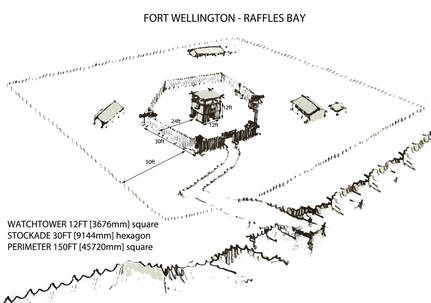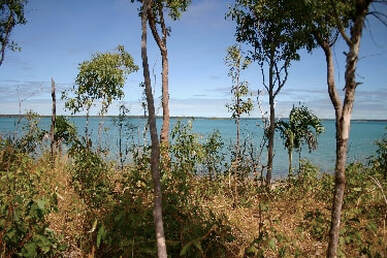FORT WELLINGTON 1827 - 1829
RAFFLES BAY
NT
Captain James Stirling (founder of Perth WA) selected the site for Fort Wellington at Raffles Bay on the Cobourg Peninsular - proclaimed on Waterloo Day 18 June 1827. Capt. HG Smyth appointed commandant - 30 soldiers of the Buffs, 14 Royal Marines, 13 Royal Navy other ranks and 22 convicts from Sydney (Grenville Pike see below)
Smyth succeeded by Capt. Collett Barker (Commandant of Solitude, Mulvaney & Green 1991 see below)
Macassans arrive in 1828 & 29 Wet Seasons
Early 1829 Fort Wellington abandoned - in the following year Macassan trepangers and their families arrived to join the settlement and begin Dry Season trepanging but the settlement was deserted.
Smyth succeeded by Capt. Collett Barker (Commandant of Solitude, Mulvaney & Green 1991 see below)
Macassans arrive in 1828 & 29 Wet Seasons
Early 1829 Fort Wellington abandoned - in the following year Macassan trepangers and their families arrived to join the settlement and begin Dry Season trepanging but the settlement was deserted.
Narrative of a Voyage Around the World
Dr. Wilson RN wrote an account of a voyage around the world in 1828. Shipwrecked in Torres Strait they sailed an open boat >1000 miles to Kupang on SW Timor. Awaiting passage to Raffles Bay on the supply ship Amity they were assisted by a French merchant Mr Bechade whose broken coffee-mill was being sent to Raffles Bay to be repaired.
On 31st June Amity arrived at Fort Wellington & Dr. Wilson “was rather astonished to find,—after the dismal accounts I had heard,—all the Europeans, men, women, and children, in good health”. Commandant, Collett Barker had approved the Macassan trepangers request to settle at Raffles Bay and they were expected in November to re-ignite the vision of an Australian Singapore. The Macassan base was in Port Essington, so Barker ordered a survey of suitable sites to start on 29th July. That morning the brig Resource was lying in the offing – she brought survivors of two shipwrecks - the Mermaid was lost on the outer Barrier Reef, her crew took to a whale-boat & after 3 days were picked up by the schooner Admiral Gifford which soon transferred them to HMS Swiftsure that was promptly wrecked off Cape York. Through all the master of the Mermaid preserved the despatches which contained orders for the abandonment of the settlement for lack of trade with the islands of the Eastern archipelago, sickness and difficulties of provisioning. ‘This intelligence caused universal regret. I do not suppose that six volunteers would have been found.. to proceed to Sydney… on reflection, it was evident that something of the kind might have been expected, from the unfavourable reports that had been… transmitted to head-quarters respecting the settlement.’ The reports by Capt. James Stirling furthered ambition for his Swan River settlement and the colony of WA which he proclaimed on 18th June 1829 – Waterloo Day & ruled as an oligarch for a decade. All the Fort Dundas and Fort Wellington buildings & stores were relocated to establish Perth which was surrounded by marginal land, 10 miles from an exposed anchorage up an unnavigable river whilst the vastly superior site of Albany on King George Sound remained the colony’s principal port until the 20th Century.
On 31st June Amity arrived at Fort Wellington & Dr. Wilson “was rather astonished to find,—after the dismal accounts I had heard,—all the Europeans, men, women, and children, in good health”. Commandant, Collett Barker had approved the Macassan trepangers request to settle at Raffles Bay and they were expected in November to re-ignite the vision of an Australian Singapore. The Macassan base was in Port Essington, so Barker ordered a survey of suitable sites to start on 29th July. That morning the brig Resource was lying in the offing – she brought survivors of two shipwrecks - the Mermaid was lost on the outer Barrier Reef, her crew took to a whale-boat & after 3 days were picked up by the schooner Admiral Gifford which soon transferred them to HMS Swiftsure that was promptly wrecked off Cape York. Through all the master of the Mermaid preserved the despatches which contained orders for the abandonment of the settlement for lack of trade with the islands of the Eastern archipelago, sickness and difficulties of provisioning. ‘This intelligence caused universal regret. I do not suppose that six volunteers would have been found.. to proceed to Sydney… on reflection, it was evident that something of the kind might have been expected, from the unfavourable reports that had been… transmitted to head-quarters respecting the settlement.’ The reports by Capt. James Stirling furthered ambition for his Swan River settlement and the colony of WA which he proclaimed on 18th June 1829 – Waterloo Day & ruled as an oligarch for a decade. All the Fort Dundas and Fort Wellington buildings & stores were relocated to establish Perth which was surrounded by marginal land, 10 miles from an exposed anchorage up an unnavigable river whilst the vastly superior site of Albany on King George Sound remained the colony’s principal port until the 20th Century.
Fort Wellington
|
'The Fort is a Hexagonal Stockade formed of Solid Timber buried four feet in the ground and raised seven feet above it being composed of Trees in an upright position having at four of the angles 18 pounder Carronades mounted on platforms to fire over the Stockade.
In the middle of the enclosed space, whose sides average forty five feet in length, there is a Cavalier or tower, twenty feet Square and twenty feet high, built of solid log work and impervious to musketry, except in the points which were left for Loopholes. Over the solid part of this Building there is raised a house for the Commandant, the under Apartments containing in safety almost all the Stores in the Settlement. Around the Fort at proper distances and in condition to flank and protect the sides of the Stockade and to be protected, are four Houses or barracks for the Troops, Marines and Prisoners, built of strong uprights and all comfortably thatched. Surrounding the whole camp there is a rough paling to prevent any body of Men from rushing in on the Sentinels [Despatch No. 100 from General Darling Governor of NSW to Lord Bathurst, Public Records Office, Kew [CO 201/193 #88355, p563] |
Origin of ‘didgeridoo - didjeridu’
|
This must be the same event though the dates are 6 months apart. It is generally accepted as the origin of ‘didgeridoo - didjeridu’ to describe the Ebroo – Eboro - Ebero; Iwaidja word Ardawirr - EAR Yidaki etc.
|
This sketch by Lt. Weston 'Dance of Aborigines of Raffles Bay' at Fort Wellington reflects a scene on described by Commandant Collet Barker’s Journal for 29th January 1829 – ‘Waterloo soon lay down on a blanket that was lent him. He appeared light headed. The others amused themselves & our people by dancing, singing, etc. Mago had brought a kind of musical instrument, a large hollow cane about 3 feet long bent at one end. From (which) he produced two or three low & tolerable clear & loud notes, answering to the tune of didoggery whoan, & he accompanied Alobo with this while he sang his treble. The Dr & some others were beating time with their hands during the first song, & when the second was going to begin Mago begged they would not add their accompaniment, which it must be confessed was not an improvement, as they beat most irregularly & must have annoyed a good timeist, as the Blacks seem to be.’ {Mulvaney & Green p113 Commandant of Solitude 1992}
|
The British Museum has been advised that there are 3 Australian species of Bamboo - the Top End variety, Bambusa Arnhemica, is green and found on the Adelaide River & Cobourg (Tiwi Is. ?) but not in East Arnhem Land - Joe Gumbula, from Milingimbi, was musician in the Elcho Island band 'Soft Sands'.
Kempthorne
"The transfer of personnel, livestock and all transportable buildings from Fort Dundas to the new site, named Fort Wellington, began in June 1827 and was completed in 1829" - "In August 1829, the same year that the last members of the garrison left Fort Dundas, Fort Wellington was evacuated." [Settlement of Solitude - see below]
“By the cutter Mermaid. S. Dowsett master which lately touched at Western port on its voyage to Sydney, we learn very unfavourable accounts of the settlements at Melville Island and Raffles Bay. That vessel sailed from Melville Island with Major Campbell and Mr Radford on board, for Raffles bay, which place she reached after a tedious voyage of 21 days. They found the whole settlement in the most sickly state, and the surgeon Dr. Wood had died. Fourteen of the worst cases were brought to Melville Island for medical aid. During their absence Mrs. Hicks, wife of Lieut. Hicks had died. Mr. Green the store-keeper, son of Captain Green of the 57th regiment had been barbarously murdered by the natives, and also Dr. Gold; the body of the latter when found, being in a horrid state, transfixed with 32 spear wounds. The Mermaid took on board 20 of the most sickly to transport to Sydney, two of whom died on the passage.” [The Hobart-Town Courier Sat. March 1. 1828]
Whilst the locations of the cemeteries at Forts Wellington & Dundas are unknown - there are 33 recorded burials at Fort Dundas between 16/1/1825 & those of Mrs Hicks, Dr Gold & JH Green on 2/11/1827 - none thereafter - which may suggest that either Dr Gold was dangerously incompetent or the hospital had been re-located to Fort Wellington - thereafter to the new Swan River Colony at Garden Island & the current site of the City of Perth in 1829.
“By the cutter Mermaid. S. Dowsett master which lately touched at Western port on its voyage to Sydney, we learn very unfavourable accounts of the settlements at Melville Island and Raffles Bay. That vessel sailed from Melville Island with Major Campbell and Mr Radford on board, for Raffles bay, which place she reached after a tedious voyage of 21 days. They found the whole settlement in the most sickly state, and the surgeon Dr. Wood had died. Fourteen of the worst cases were brought to Melville Island for medical aid. During their absence Mrs. Hicks, wife of Lieut. Hicks had died. Mr. Green the store-keeper, son of Captain Green of the 57th regiment had been barbarously murdered by the natives, and also Dr. Gold; the body of the latter when found, being in a horrid state, transfixed with 32 spear wounds. The Mermaid took on board 20 of the most sickly to transport to Sydney, two of whom died on the passage.” [The Hobart-Town Courier Sat. March 1. 1828]
Whilst the locations of the cemeteries at Forts Wellington & Dundas are unknown - there are 33 recorded burials at Fort Dundas between 16/1/1825 & those of Mrs Hicks, Dr Gold & JH Green on 2/11/1827 - none thereafter - which may suggest that either Dr Gold was dangerously incompetent or the hospital had been re-located to Fort Wellington - thereafter to the new Swan River Colony at Garden Island & the current site of the City of Perth in 1829.
|
SETTLEMENT OF SOLITUDE: AN ASSESSMENT OF THE SITE OF FORT WELLINGTON, RAFFLES BAY by Clayton Fredericksen and Colin De La Rue
|
| ||||||
NT Historical Society - artist's impression 1971
Fort Wellington, Raffles Bay.
Other Authors Historical Society of the Northern Territory Expedition to Fort Wellington (1966 : Raffles Bay, N.T.)
Published Darwin : Historical Society of the Northern Territory, 1971.
Account of expedition, Aug.-Sept. 1966, to Fort Wellington; includes historical notes on settlement and foundation, contact with natives of Iwaidja and Jacko tribes; Macassans known to have fished and traded in the area for many years.
Other Authors Historical Society of the Northern Territory Expedition to Fort Wellington (1966 : Raffles Bay, N.T.)
Published Darwin : Historical Society of the Northern Territory, 1971.
Account of expedition, Aug.-Sept. 1966, to Fort Wellington; includes historical notes on settlement and foundation, contact with natives of Iwaidja and Jacko tribes; Macassans known to have fished and traded in the area for many years.
Louis Le Breton 1839
Louis Le Breton joined Dumont D' Urville's 1837-1840 expedition as the ship's doctor in the Astrolabe but assumed the role of artist following the incumbent's death.
Louis Le Breton (French, 1818-1866).Observatoire De La Baie Raffles [Raffles Bay, Northern Territory]1846. Hand-coloured lithograph, text including artist and title above and below image, 18.1 x 31.1cm (image). Repaired tear to image right side, slight creases to upper and left edges. Framed.
Text reads “Dessiné par Le Breton, lith. par Lassalle. Gide editeur. Imp. Lemercier, Benard & Co. Voyage au Pole Sud et Dans L’oceanie, Atlas Pittoresque, pl. 116.” Held in NLA.
Raffles Bay, alongside Port Essington in the Northern Territory, was the site of an early attempt by the British to establish a settlement on Australia’s northern coastline but was abandoned in 1829. The bay was named in 1818 by explorer Phillip Parker King after Sir Thomas Stamford Raffles, a British statesman, best known for his founding of Singapore and the British Malaya. Ref: Wiki.
Text reads “Dessiné par Le Breton, lith. par Lassalle. Gide editeur. Imp. Lemercier, Benard & Co. Voyage au Pole Sud et Dans L’oceanie, Atlas Pittoresque, pl. 116.” Held in NLA.
Raffles Bay, alongside Port Essington in the Northern Territory, was the site of an early attempt by the British to establish a settlement on Australia’s northern coastline but was abandoned in 1829. The bay was named in 1818 by explorer Phillip Parker King after Sir Thomas Stamford Raffles, a British statesman, best known for his founding of Singapore and the British Malaya. Ref: Wiki.
